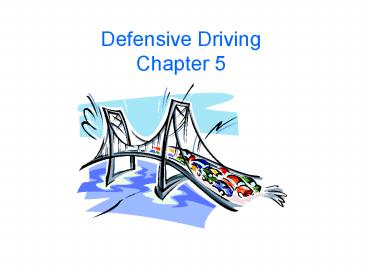Defensive Driving Chapter 5 - PowerPoint PPT Presentation
1 / 16
Title: Defensive Driving Chapter 5
1
Defensive DrivingChapter 5
2
CHAPTER FIVE Defensive Driving PREVENTING
ACCIDENTS Prevention Formula 1. Be Alert 2.
Be Prepared 3. Act In Time Describe the
Actions of an Aggressive Driver 1.
Speeding 2. Improper or excessive lane
changing 3. Improper passing
3
- Define Road Rage
- Occurs when motorists lose their tempers or
become frustrated because of a traffic
disturbance. - Seven Characteristics of Road Rage
- 1. Run stop signs or red lights 4. Weave
through traffic - 2. Speed 5. Honk horn/flash high beams
- 3. Tailgate 6. Unsafe lane change
- 7. Hand or facial gestures
4
Distractions
- Collisions are caused by distracted drivers!!
- Smoking eating cell phone
- Applying make-up Adjusting radio
- Reading maps or newspapers shaving
Remove coat watching children or pets - Finding toll money texting using laptop
- fastening seatbelt while driving
5
- Highway Hypnosis
- Definition
- After long hours of driving you feel trance-like
with sounds of the wind, tires and hum of the
engine dulling your senses. - Tips to Prevent Highway Hypnosis
- 1. Rest before you start.
- 2. Do not take any drugs that may make you
drowsy. - 3. Do not drive long hours or late at night.
Only 300-400 miles a day - 4. Rest stops every two hours.
- 5. Switch off with another driver every hour or
so. - 6. Keep shifting your eyes from one part of the
road to another. - 7. Chew gum or sing with the radio.
- 8. Roll down window and get fresh air.
6
Communicating with Other Drivers
- Turn signals or hand signals
- Catch other motorists eyes
- Tap Horn
7
- FOLLOWING DISTANCES
- Tailgating is a common cause of accidents in
NJ!! - 1. One Car Length Method
- One car length back for each ten
miles per hour of speed. - 2. Three-Second Rule
- Choose a fixed object as the car in front of
you passes it. Begin counting to three seconds.
It should take three seconds before you pass
the object. - 3. In bad weather, the three-second rule
should be increased to four or more seconds.
8
- Passing Changing Lanes
- A. List points necessary when passing or
changing lanes - 1. only pass if necessary 6. signal
every lane change - 2. only pass if it can be completed
7. tap horn to signal - without speeding driver
ahead - 3. keep a safe following distance 8.
return to lane when vehicle
being passed is - seen in rearview mirror
- 4. Check traffic ahead and behind 9.
cancel the turn signal - 5. Only pass when road signs and
- pavement markings permit
- B. What should you do when being passed?
- Slow down and make it easier to
pass you
9
- ROAD CONDITIONS
- Wet Roads
- 1. Drive more slowly
- 2. Complete turns and stopping with care
- 3. Increase two-second rule to four or more
seconds - 4. When are the roads the most slippery
during a rain storm? - First few minutes rain mixes with
oil on road surface - 5. If you drive through a deep puddle,
what should you do to test the brakes? - Test brakes by applying gentle
pressure
10
Hydroplaning
- Definition a driving condition where tires lose
traction on a wet road and float on a layer of
water or slush. - 2. To avoid hydroplaning do not drive on
badly worn tires, slow down when raining or
standing water or slush on road.
11
- Snow and Ice
- What should be done before driving in cold
weather? - 1. Let vehicle warm up
- 2. Remove all snow and ice from car,
including roof! - 3. Check for windshield wiper fluid
- Braking precautions
- 1. Anti-lock brakes- apply steady pressure
(DO NOT PUMP) - 2. Conventional brakes- gently pump brakes
do not lock wheels
12
- Fog
- Increase following distance to 6-seconds
- 1. SLOW DOWN!!
- 2. Keep headlights on low beam and use fog
lights - 3. Use pavement markings and other vehicles
lights to guide you.
13
- Night Driving
- Vision is reduced, what should be done to remain
safe while driving at night? - a. Keep a safe speed.
- b. Drive within the range of your headlights
- What factors should be considered when driving
at night? - a. Speed
- b. reaction time (distance traveled before
hitting brake) - c. braking distance (distance needed to
completely stop) - d. Watch for unlit vehicles, pedestrians and
animals
14
- ADJUSTING TO DIFFERENT ROADS
- City Driving
- 1. A driver must handle many more
- driving tasks in the city.
- 2. Drive more slowly and watch for the movements
of others. - 3. Develop the habit of looking 12 seconds
ahead. - 4. When approaching an intersection, reduce
speed, look right and left, COVER your brake. - 5. Watch for uncontrolled intersections-no signs
or lights.
15
- Highway Driving
- 1. Stay alert!!
- 2. Stay within the speed limit!
- 3. Keep eyes moving!
- 4. Keep mind alert!
- 5. Always be ready to react to the unexpected!
16
- Secondary Roads
- These roads are not designed for heavy traffic.
SLOW DOWN!! - Curves
- 1. Slow down before getting to the curve. Your
car will tend to go straight. - 2. Once in the curve, maintain a steady speed.
- Road Hazards
- 1. Include hills, dips narrow bridges, bumps
and railroad tracks. - 2. Slow Down!
- 3. Speeding and applying the brakes hard can
cause a skid. - Construction Zones
- 1. Traffic fines double!! Slow Down!!































